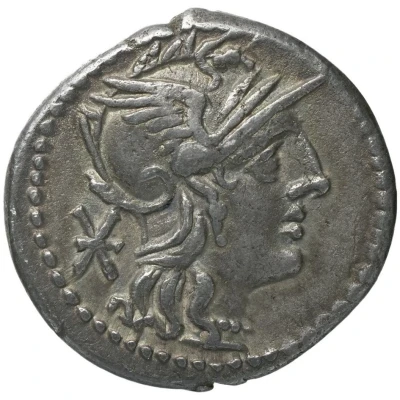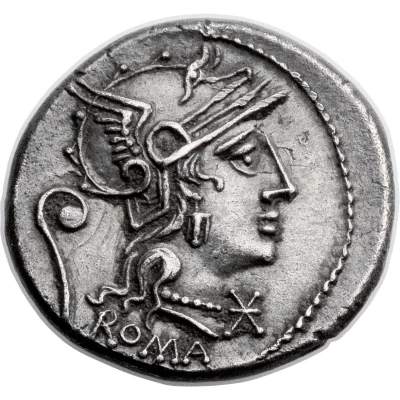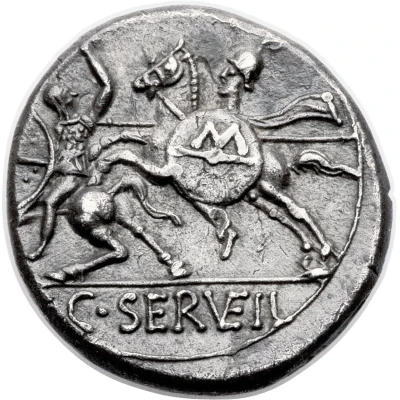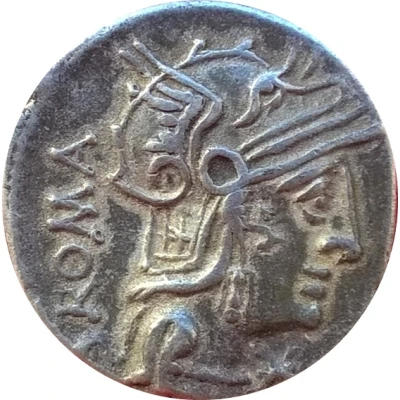
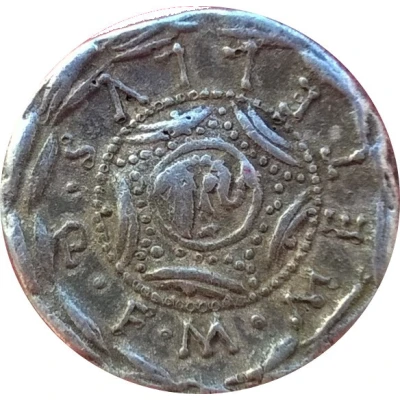

© EPHESE
Denarius - Marcus Caecilius Metellus ROMA / M•METELLVS•Q•F 127 BC
127 BC year| Silver (.950) | 3.7 g | 17 mm |
| Issuer | Rome › Roman Republic (509 BC - 27 BC) |
|---|---|
| Period | Republic (509 BC - 27 BC) |
| Type | Standard circulation coin |
| Year | 127 BC |
| Value | Denarius (1) |
| Currency | Denarius of 16 Asses (141 – 27 BC) |
| Composition | Silver (.950) |
| Weight | 3.7 g |
| Diameter | 17 mm |
| Thickness | 2 mm |
| Shape | Round (irregular) |
| Technique | Hammered |
| Orientation | Variable alignment ↺ |
| Demonetized | Yes |
| Updated | 2024-10-06 |
| Numista | N#125646 |
|---|---|
| Rarity index | 90% |
Reverse
Macedonian shield with elephant's head in central boss, surrounded by laurel wreath.
Script: Latin
Lettering: M•METELLVS•Q•F
Unabridged legend: Marcus Metellus Quinti Filius
Translation: Marc Metellus, son of Quintus
Comment
Marcus Cæcilius Metellus Quintus Junior was the third son of Quintus Cæcilius Metellus Macedonicus. The coins attributed to him seem almost certain. He served as monetary magistrate alongside Quintus Fabius Maximus Eburnus and Caius Servilius around 631 a.u.c (123 BC). He became consul in 639 a.u.c (115 BC) with M. Aemilius Scaurus. The following year, he was sent as proconsul to Sardinia, and after defeating the rebellious islanders, he returned to Rome triumphant.The round shield on his silver and bronze coins is the Macedonian shield, as seen on the coins of the ancient kings of Macedonia. Like the laurel wreath surrounding it, it recalls the victories won in this country by the father of money, mentioned above, and in particular his triumph over the revolt of Andriscus in 148 BC, after which Macedonia became a Roman province. The umbo of the shield features an elephant's head to commemorate the victory of another of his ancestors, Lucius Cæcilius Metellus, over Carthaginian elephants at Panorme in 503 a.u.c (251 B.C.).
Cavedoni and Mommsen have pointed out an interesting fact: the monetaries Marcus Cæcilius Metellus Quinti filius, Quintus Fabius Maximus Eburnus and Caius Servilius, who together were triumvirs, each struck two classes of denarius: one with the head of Rome, the other with the head of Apollo; the reverse is the same for both series. But what seems strange is that the coins with Apollo's head are in a different style from the others, which could lead us to classify them as from a much more recent period. Mommsen assumes that the denarii with the head of Rome were reissued thirty or forty years after their first issue, but this time with the head of Apollo. It might be preferable to assume that these coins came from a provincial workshop.
Interesting fact
The Denarius coin featuring Marcus Caecilius Metellus was issued during a time of significant political and social change in Rome. The coin was minted in 127 BC, just a few years before the death of Julius Caesar and the subsequent power struggle that led to the end of the Roman Republic and the rise of the Roman Empire. This coin is a representation of the political and economic systems that were in place during this time period. The image of Metellus on the coin serves as a symbol of the Roman Republic's values and ideals, while the silver content and weight of the coin reflect the economic standards and practices of the time. Overall, this coin provides a unique window into the history and culture of ancient Rome, and serves as a reminder of the complex and dynamic nature of the civilization that once ruled much of the known world.
Price
| Date | Mintage | VG | F | VF | XF | AU | UNC |
|---|---|---|---|---|---|---|---|
| ND (-127) | - | - | - | - | - | - |
Values in the table are based on evaluations by sales realized on Internet platforms. They serve as an indication only for Denarius - Marcus Caecilius Metellus (ROMA / M•METELLVS•Q•F) (127 BC) coin.
